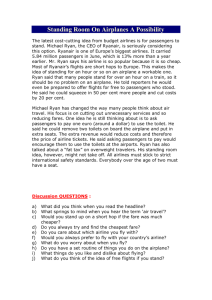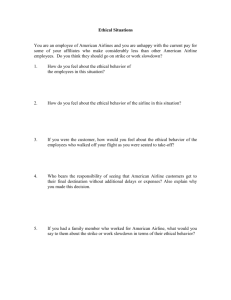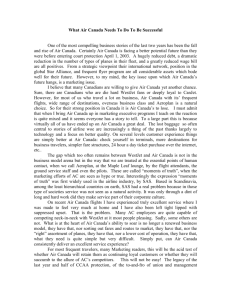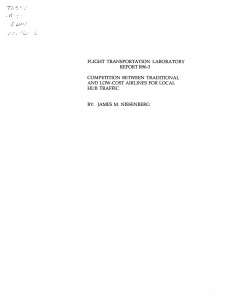Airline Marketing
advertisement
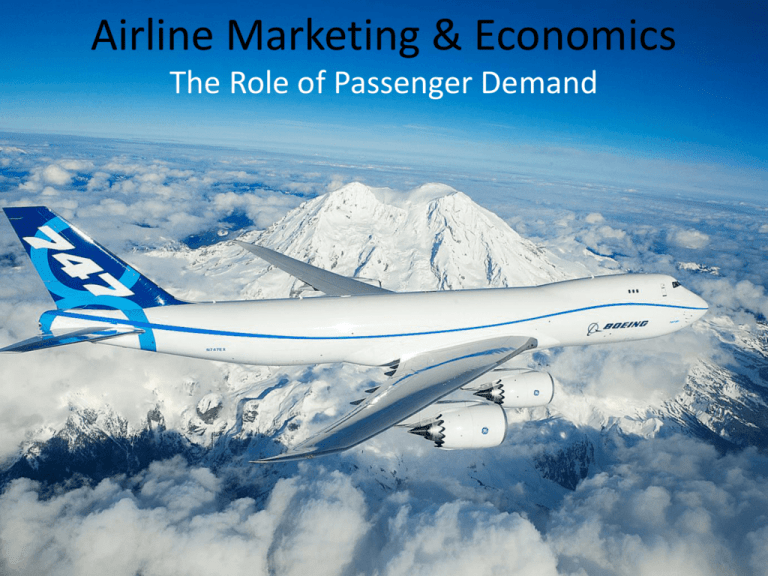
Airline Marketing & Economics The Role of Passenger Demand Airline Marketing and Economics Jonathon Robert Nield Graduate Student Aviation Management and Human Factors Arizona State University June 30, 2010 “So long as the airlines preserve their magic quality, including, above all, their safety and reliability — they will be guaranteed a significant role in the workings of the world. Science will never digitalize an embrace. Electronics will never convey the wavering eye of a negotiating adversary. Fiber-optic cable can do many things, but it cannot transport hot sand, fast snow, or great ruins.” — Thomas Petzinger, Jr., ‘Hard Landing’ The Interaction of Supply and Demand • Supply and Demand not independent • Bottom Line: Unit Revenues>Unit Costs • 3 Key Performance Variables – Unit Costs • ATK/ATM: per available tonne-km/mi • CASK/CASM: per available seat km/mi – Unit Revenues • RTK/RTM: Per revenue tonne-km/mi • RASK/RASM: Per available seat km/mi – Load Factors • Percentage of tonnes/seat sold against available Airline Planning • Aircraft Selection • Scheduling • Product Planning • Pricing • Advertising • Route Development Supply-Side These factors influence but do not dictate demand: – Aircraft types – Speed – Departure & arrival times – Frequency – Air fares – In-flight services – Ground handling Demand-Side • Demand influences but does not dictate supply such as: -Density of -Purpose of -Nature of demand travel freight demand -Seasonality -Distance • These demands will also cause fluctuations in cost. • The dynamic nature of demand necessitates the need to introduce new services which further impacts demand. Key Stages of Airline Marketing • Marketing is not simply selling what is produced! • Marketing is traditionally the 4-Ps – Product --Price –Promotion --Place – A service like an airline is marketed differently than a product. What are the differences between these two products? What are the differences between these two products? • Did you have an easy or hard time identifying some ways Delta service is significantly different than United? • Did you have an easy or hard time identifying the some ways Southwest service is significantly different than AirTran? • The ability and ease for a consumer to identify how one airline is different than the other is a result of branding and positioning. Some do it better than others. Far too often, airlines look at the world through their airline industry goggles and approach problems based on precedent within the industry. Lets take off our airline goggles and look at universal marketing concepts and APPLY those to the airline industry. • Exclusivity Product – An airline cannot patent flying passengers from Point A to Point B – Must lock in services exclusive to carrier (UnitedStarbucks) • Branding – No tangibility creates necessity for brand name or logo recognition (Frontier) • Capacity Management – Inseparability of service from provider – Perishability of service: If not used, it is lost (Empty Seat) Pricing • Used to affect consumer perceptions • Used to affect capacity management • Services often use low-peak pricing strategies Place (Distribution) • Inseparability of production and consumption • Distribution of services important to provide adequate access at the right time, to right people, at right price (interdependence of the 4Ps) • Electronic distribution is becoming increasingly vital to service providers (airlines). Promotion • Promotion must stress: – Availability – Courteous Service – Location – Image (Brand Positioning) – Consistent Quality – Efficient • Publicity increasingly playing a role in promotion (Spirit) Core Competencies • Best Price: Allegiant, Spirit, Air Tran • Best Product: Continental • Best Service: Southwest Airlines Back to looking at marketing with our airline goggles on… Key Stages of Airline Marketing • The key to successful marketing is to demand oriented, not supply oriented. • Example of the Concorde: Technically possible to supply but not successfully marketable based on consumer demands. Key Stages of Airline Marketing • Step 1: Identify profitable markets – Which markets have demand that is underserved • Step 2: Decision of products and services to offer each market – “Price is most critical of the product features.” Doganis – I strongly disagree with this statement. Product differentiation is the most important whether that be price or level of service. This misconception is what is killing the legacy carriers. – Must balance cost of features with consumers’ willingness to pay as well as competitive pressures. Key Stages of Airline Marketing • Step 3: Plan and organize the distribution and selling of the products. – Includes promotional activity • Step 4: Reviewing and monitoring market performance and benchmarking against the set goals Motivation for Air Travel (UK) London Heathrow % London Gatwick % Business 4.5 1.6 Attend internal co. biz 12.6 6.2 Meeting Customers 10.8 5.4 Conference 3.6 1.3 Other Business 4.3 2.4 Total Business 36.1 17.0 Holiday 18.1 25.8 Holiday Tour/Package 10.1 29.2 Total Holiday 28.2 55.0 Visiting Friends/Family 31.9 26.0 Other (Sports, Studies) 3.8 2.0 Total 100.0 100.0 Total Pax (Domestic & Intl) 67.1 Million 33.7 Million Business Holiday *Table 8.1 Doganis Socio-economic Characteristics • Travel motivation and aspects of travel behavior are linked to certain socio-economic factors. – Sex --Age --Income --Stage in life --Family Size – Occupation • More an airline knows about current or future market, the better it can target its product and services Market Segmentation • Traditionally segmented as business or leisure • Segmentation in invaluable since each segment has varied growth rates, • Respond differently to internal supply factors: – Frequency – Departure times – Fare changes • External Factors – Exchange rate fluctuation – Economic Recession Market Segmentation • Market segmentation increasingly based on passenger needs and behavior patterns • Various needs that attract business travelers: – Attention Seekers – Comfort Cravers – Schedule Seekers • Various needs that attract leisure travelers: – Schedule Seekers – Service Seekers – Nervous Nellies The Seasonality Problem • Airline industry is marked by daily, weekly, and season peaks and troughs. • Patterns are affected by geography and routes. • The higher the ratio of peaks and troughs, the more difficult effective utilization becomes. The Seasonality Problems • Other factors that affects demand spikes: – Climate cycles – Cultural and religious occasions – Sporting events (Particular challenge) The Seasonality Problem • Daily and Weekly peaks • Daily peaks occur early morning and early evening due to business travel • Weekly peaks occur Monday, Tuesday, and Fridays but depending on culture that may fluctuate. • Airlines reallocate excess capacity on off-peak days. • LCCs tend to maintain consistent capacity yearround Factors Affecting Passenger Demand Factors Affecting All Markets Factors Affecting Particular Routes Level of personal disposable income Level of tourist attractions Supply Conditions: Scenic/climatic/historical/religious att. Fare Levels Adequacy of tourist infrastructure Speed of air travel Comparative Prices Convenience of air travel Exchange Rate Fluctuations Level of economic activity/trade Travel Restrictions Population size & growth rate Historical/Cultural Links Social Environment Earlier population movements Length of paid holidays Current Labor Flows Attitudes to travel Nature of economic activity Factors Affecting Passenger Demand • Price of air transport and level of distribution of personal income contribute most significantly to demand in markets. • Much of the growth in the last 40 years can be attributed to rising per capita income across globe. • Strong correlation between GDP and air travel demand. Factors Affecting Passenger Demand • Demand and supply interaction is not restricted to pricing. – Frequency – Seat availability --Departure Times --Stops • Other factors of cost affecting travelers affects air travel demand • Political effects Income and Price Elasticity of Demand • Leisure travelers tend to spend more on air travel as personal income rises. • Income elasticity= % Change in Demand % Change in Income Income and Price Elasticity of Demand • Business travelers activity correlated with the GDP of a country. • Business travelers tend to have lower elasticity than leisure travelers. • Other indicators are volume of trade and exchange rates. Income and Price Elasticity of Demand • Price elasticity= % Change in Demand % Change in price/fare • Always negative since demand and price are inversely related • Leisure travelers exhibit higher price elasticity than business travelers. Cross-Elasticity of Demand • Measures the responsiveness of demand for product “A” to the price of product “B”. • Example: – If Southwest Airlines fares are lower than United’s, passengers will be diverted to Southwest Airlines. • This concept is too complex to discuss in detail in this presentation but decisions within markets need to be made with elasticity in mind. The Pricing Puzzle Short-haul international return flight 200 seats and $100 single fare Total seats offered per day (200 each way) 400 Business Passengers (approx 50 each way) 100 Leisure Passengers (approx 50 each way) 100 Daily Seat Factor (200pax in 400 seats) 50% Revenue from business market $10,000 Revenue from leisure market $10,000 Total Revenue per Day $20,000 The Pricing Puzzle Impact of $110 fare Total seats offered per day (200 each way) 400 Business Passengers 92 Leisure Passengers 80 Daily Seat Factor 43% Revenue from business market $10,120 Revenue from leisure market $8,800 Total Revenue per Day $18,920 The Pricing Puzzle Impact of $90 fare Total seats offered per day (200 each way) 400 Business Passengers 108 Leisure Passengers 120 Daily Seat Factor 57% Revenue from business market $9,720 Revenue from leisure market $10,800 Total Revenue per Day $20,520 BCG Analysis Southwest Airlines Market Growth Rate •Denver-Phoenix High •Denver-Las Vegas •Denver-LaGuardia •Denver-Seattle •Denver-Milwaukee Stars Question Marks •Phoenix-Los Angeles •Los Angeles-Las Vegas •Atlanta-Nashville •Little Rock-Boise •Cheyenne-Dallas Cash Cows Dogs Low High Low Relative Market Share SWOT Analysis Southwest Airlines Favorable Unfavorable Internal STRENGTHS •Well known brand among U.S. Consumers •High market share of domestic pax •Highly regarded for corporate social responsibility WEAKNESSES •Increasing labor costs •Relatively weak business travel utilization •737 Fuel inefficiencies •Information Technology challenges External OPPORTUNITIES •Increasing dissatisfaction with legacy carriers •Low cost solution demand for international travel •Technology advancements improving efficiencies THREATS •Fuel costs •Increasing lower cost competition •Government regulations •Airport/Network congestion •Union coercion and pressures Relationship Marketing • Mass Marketing vs Relationship Marketing • Traditional vs Social Media • Discuss videos Thank You Questions? Jnield@asu.edu Thank you to Boeing Company and Airliners.net for the usage of these photos. Kerin, Hartley, Rudelius. Marketing: The Core, McGraw Hill, 2004. Doganis, Rigas. Flying Off Course: Airline Economics and Marketing. Routledge, 2010.

